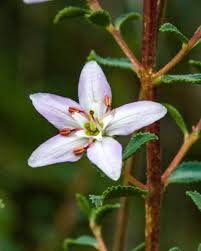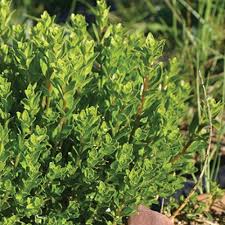Buchu
- Dave

- Apr 11
- 4 min read
Buchu

Botanical Name
Agathosma Betulina
Common Name
Buchu, round-leaf buchu
Family
Rutaceae
Parts Used
Leaf
Native To
South Africa
Harvesting Guidelines
Buchu should be harvested from wild or cultivated plants that are mature enough to produce leaves but not over-harvested to avoid depleting natural populations. It is recommended to harvest the leaves in the spring when the plant is in full growth but before flowering. Leaves should be carefully harvested, avoiding damage to the plant. Fresh leaves can be dried in the shade and stored for later use.
To maintain sustainability, only a portion of the leaves should be harvested at a time, allowing the plant to continue to grow and regenerate.
Agathosma betulina, commonly known as Buchu, is a small shrub native to South Africa, primarily found in the Western and Eastern Cape regions. Buchu has been used for centuries in traditional medicine by indigenous communities, particularly the Khoikhoi people, for its therapeutic properties. It has a rich history as a natural remedy for various ailments, particularly urinary tract and kidney issues, and continues to be utilized in modern herbalism. The leaves of the Buchu plant are the part typically used for medicinal purposes.
Traditional and Indigenous Use
Indigenous people of Southern Africa, especially the Khoi, have long used Buchu for its diuretic, anti-inflammatory, and antiseptic properties. The plant was traditionally used as a remedy for urinary tract infections, kidney problems, and to improve digestive function. Buchu was also utilized as an antiseptic and to treat colds, coughs, and fevers.
In addition, Buchu was employed in a variety of ways, including as a poultice for sore muscles and as a general tonic for health. The leaves were often steeped in hot water or made into a tincture to treat both internal and external ailments.
Harvesting Guidelines
Buchu should be harvested from wild or cultivated plants that are mature enough to produce leaves but not over-harvested to avoid depleting natural populations. It is recommended to harvest the leaves in the spring when the plant is in full growth but before flowering. Leaves should be carefully harvested, avoiding damage to the plant. Fresh leaves can be dried in the shade and stored for later use.
To maintain sustainability, only a portion of the leaves should be harvested at a time, allowing the plant to continue to grow and regenerate.
Botanical Description
Buchu is a small shrub that typically grows to about 50-80 cm in height. It has leathery, aromatic leaves that are oval to round in shape with a glossy green appearance. The plant produces small, star-like white to pink flowers in clusters, typically blooming in late spring to early summer. The leaves are the primary medicinal part of the plant, often dried for use in teas, tinctures, or capsules.
Constituents
The leaves of Agathosma betulina contain a variety of bioactive compounds, including essential oils such as:
diosphenol
isoquercetin
flavonoids (such as quercetin)
tannins
volatile oils (including menthone, pulegone, and limonene)
These constituents contribute to Buchu's diuretic, anti-inflammatory, and antimicrobial properties.
Actions and Properties
Diuretic: Buchu is well known for its ability to increase urine output, making it a powerful herb for treating urinary tract infections and kidney-related ailments.
Anti-inflammatory: The plant's compounds help reduce inflammation, especially within the urinary tract and kidneys.
Antiseptic: The essential oils in Buchu are thought to have antimicrobial effects, which is why it is often used in the treatment of infections.
Antioxidant: The flavonoids in Buchu provide antioxidant properties, supporting general health by neutralizing free radicals.
Carminative: Buchu helps alleviate digestive issues such as indigestion, bloating, and cramps.
Modern Uses
In modern herbalism, Buchu is primarily used to support urinary tract and kidney health. It is often included in formulations for the treatment of:
Urinary tract infections (UTIs)
Kidney and bladder issues, such as cystitis or urinary retention
Inflammation of the urinary system
Digestive complaints, especially related to bloating and indigestion
Buchu is available in various forms, including teas, tinctures, capsules, and essential oils. It is also used in some skincare products due to its antiseptic and anti-inflammatory properties.
Scientific Studies
Research has validated many of the traditional uses of Buchu. Studies have demonstrated that Buchu possesses significant antimicrobial activity, particularly against urinary pathogens like E. coli, a common cause of urinary tract infections. Other studies have highlighted its diuretic properties, supporting its traditional use in promoting urinary flow and reducing fluid retention.
A 2013 study published in the "Journal of Ethnopharmacology" found that Buchu leaf extracts exhibit both anti-inflammatory and antimicrobial properties, which contribute to its effectiveness in treating urinary tract infections and other infections. Another study in 2011 confirmed its diuretic effect, which can support kidney health and aid in detoxification.
Harvesting and Safety Considerations
While Buchu is generally considered safe for most people, it should be used with caution in certain individuals, particularly those who are pregnant or breastfeeding. The herb should not be used in conjunction with certain medications, such as diuretics, because it may intensify their effects.
As with any herb, it is essential to use Buchu in moderation and consult with a healthcare provider before use, especially if you have pre-existing medical conditions or are taking prescription medications.
Adult Dosage
Tea: 1-2 teaspoons of dried leaves steeped in 8 oz of water, 2-3 times per day.
Tincture: 1-2 ml (1:5, 40% alcohol) 3 times per day.
Capsules: 500 mg to 1 g, 2-3 times per day.
Safety
Buchu is typically safe when used correctly, but there are a few safety considerations:
May interact with diuretics and medications that affect kidney function.
Should be avoided during pregnancy and breastfeeding unless under the guidance of a healthcare professional.
High doses or prolonged use could irritate the kidneys or urinary tract.
Energetics
Cooling
Drying
References
Tierra, M. (1998). The Way of Herbs. New York, NY: Pocket Books.
Van Wyk, B. E., & Gericke, N. (2000). People’s Plants: A Guide to Useful Plants of Southern Africa. Pretoria, South Africa: Briza Publications.
Mills, S., & Bone, K. (2005). The Essential Guide to Herbal Safety. St. Louis, MO: Elsevier.







